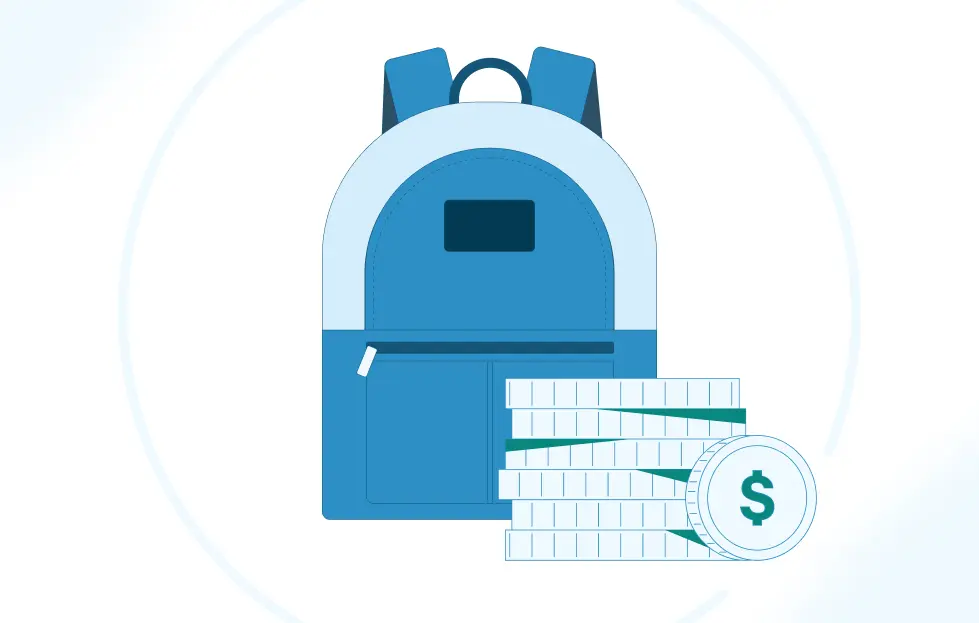- Intro
- Trend No.1
Employer-sponsored education savings benefits are gaining momentum in response to student debt challenges.
- Trend No.2
Savers are increasingly seeking more personalized financial wellness solutions.
- Trend No.3
Workplace retirement plans have moved from perk to prerequisite.
- Trend No.4
Saver demand continues to grow for more comprehensive and inclusive workplace financial wellness benefits.
- Spotlight
ABLE Savings Accounts
- Conclusion
Workplace Financial Wellness: Beyond the 401(k)

The Future of Financial Wellness & Workplace Savings
The annual Vestwell Savings Industry Report surveys over 1,200 savers on the platform from across the United States, offering invaluable insights into the nation's current saving habits and evolving preferences. The results also revealed challenging financial circumstances for many of today's savers: 38% of respondents have less than $1,000 in emergency savings, and 29% have none. However, the Consumer Financial Protection Bureau (CFPB) states that the median amount of money people report they and their family need in savings for emergencies is $10,000. These challenges present the opportunity for financial advisors and employers to leverage modern technology to make saving more accessible for individuals, regardless of their financial position.
The SECURE Act 2.0 is ushering in exciting new opportunities for savings programs, expanding access to retirement savings and enabling employers to offer workplace benefits such as student loan repayment assistance and emergency savings options. Workplace retirement plans have become a standard expectation for employees, and looking forward, the “next best dollar” for many savers will be invested in a diverse array of financial wellness solutions, including education savings accounts, emergency savings accounts (ESAs), and health savings accounts (HSAs). This new era of financial wellness presents an opportunity for employers and advisors to broaden their offerings regarding workplace benefits and financial resources.
The results of our survey show four emerging trends for 2024 that point to a more comprehensive approach to financial wellness. We explore these trends to understand how savers might strategically allocate their "next best dollar" in the new year—and how employers and advisors can align their offerings with these evolving priorities.
Key Findings
- Employer-sponsored education savings benefits are gaining momentum in response to student debt challenges.
- Savers are increasingly seeking more personalized financial wellness solutions.
- Workplace retirement plans have moved from perk to prerequisite.
- Saver demand continues to grow for more comprehensive and inclusive workplace financial wellness benefits.
At Vestwell, we are driven by a singular mission: to close the American savings gap. We are transforming how Americans achieve financial security through innovation, education, and a focus on personalized and scalable financial solutions. Our goal is to empower savers, employers, and advisors, ensuring that every "next best dollar" is invested wisely for a stronger and more secure financial future.
Question: Which Savings Accounts Do You Currently Have? (Please Select All That Apply)
- 59.0%401(k)
- 22.5%Roth IRA
- 12.5%Individual Retirement Account (IRA)
- 5.7%Health Savings Account (HSA)
- 4.7%529 Education Savings Account
- 2.4%403(b)
- 1.9%Emergency Savings Account (ESA)
- 0.2%ABLE Savings Account (Savings for those with disabilities)
Employer-sponsored education savings benefits are gaining momentum in response to student debt challenges.

Student debt is a significant obstacle to retirement savings. 93% of employees with student loans say that their student debt has affected their ability to save for retirement. The resumption of student loan payments in October 2023, after a three-year pandemic pause, has likely exacerbated the financial pressure for many.
The survey results further highlight a strong demand for employer solutions to this challenge. A large majority (89%) of respondents with student loans believe that having a student loan repayment benefit in the workplace is at least somewhat important. This sentiment is further echoed by the fact that 74% of those with student loans agree that they would be more likely to continue working for an employer that offered student loan-related benefits.
These findings indicate that student loans significantly hinder individuals' ability to save for retirement, and there is a strong call for employer support. By addressing this pain point, employers can strengthen employee retention and demonstrate a commitment to their employees’ holistic financial well-being.
Question: If You’re Currently Repaying Student Loans, How Much Do Those Payments Affect Your Ability To Save for Retirement?
- Significantly; it's a major obstacle to saving
- 47.6%
- Moderately; it has some impact on my saving ability
- 25.2%
- Slightly; it affects my saving ability but not much
- 20.1%
- Not at all; I can manage both comfortably
- 7.1%
The Rise of 529 Education Savings Accounts
Employers and financial advisors can also capitalize on the rising demand for education savings by providing employees and clients with information about 529 Education Savings Accounts. These accounts are tax-advantaged savings plans sponsored by states, state agencies, or educational institutions and are designed to encourage saving for future education costs. Only 42% of savers are at least somewhat aware of the tax benefits of 529 Education Savings Accounts, and only 5% of those we surveyed with a 401(k) on the Vestwell platform currently have one.
By partnering with their state’s 529 Program to offer education savings as a workplace benefit, employers can help their employees prepare for education-related expenses. Among employees currently saving for educational expenses, 73% placed some level of importance on having a 529 Education Savings Account in their workplace benefits package. For employers looking to differentiate themselves, providing a benefit that enhances their employees’ overall financial stability can be an effective strategy.
Question: Are You Familiar With the Tax Benefits of 529 Education Savings Accounts?
- No; this is new information to me
- 39.9%
- Yes; I understand the tax benefits well
- 24.3%
- Somewhat; I know there are benefits but not in detail
- 18.1%
- Not really; I have limited knowledge about them
- 17.7%
Savers are increasingly seeking more personalized financial wellness solutions.

Our survey has revealed a trend among savers: a growing preference for customized financial guidance via financial advisors, managed accounts, and digital tools. This preference reshapes workplace benefits as savers seek more tailored approaches to manage their finances amid economic challenges.
A notable 41% of savers surveyed by Vestwell do not currently work with a financial advisor but plan to in the future. Among those who plan to work with an advisor, 41% intend to find one through referrals from friends or family, 21% through internet research, and 19% through their employer.
There is also a burgeoning interest in digital tools for personal finance management. 65% of respondents think an online platform with real-time balance checking would be helpful when managing their finances, and 94% say that a tool that offers digital personalized investment suggestions would be valuable. Accordingly, there was a 171% year-over-year increase in contributions going into managed accounts on Vestwell’s platform between October 2022 and October 2023.
Question: If You Plan To Work With a Financial Advisor, How Do You Intend To Find One?
- Through referrals from friends or family
- 41.0%
- Through internet research
- 21.0%
- Through my employer
- 18.6%
- Through my bank
- 11.1%
- Other (please specify)
- 8.3%
Successful Workplace Benefits Programs Are Leveraging Personalization at Scale
Savers are actively seeking more informed and efficient ways to navigate their finances, especially amid economic uncertainties. This is an excellent opportunity for employers to stand out in the competitive job market by offering personalized financial wellness solutions, including digital tools, managed accounts, and access to financial advisors. A combination of user-friendly digital platforms and professional advice has become central to effective financial planning and wealth management.
Workplace retirement plans have moved from perk to prerequisite.

High inflation, high interest rates, and a pessimistic economic outlook characterized the year 2023. Most savers (79%) say that inflation has impacted their ability to save for retirement, and 76% of savers are stressed about their finances.
Amid this increased financial stress and economic uncertainty, savers increasingly view employer-sponsored retirement plans as essential, not optional: 85% of respondents expect their employer to offer retirement benefits, compared to 72% last year. Additionally, 89% would be more likely to continue working for an employer that offered a retirement benefit. These data indicate that workplace retirement plans are more than just a perk; they are a fundamental aspect of employee satisfaction and retention.
Question: If You Described Yourself As Stressed About Your Financial Situation, Which of the Following Areas of Your Life Does This Impact? (Please Select All That Apply)
- 48.6%Mental health
- 33.3%Sleep
- 23.1%Personal relationships
- 25.2%Self-esteem
- 18.3%Physical health
- 11.1%Performance at work
- 3.7%Other (please specify)
Bridging the Savings Gap: Addressing Affordability Concerns and Expectations
Respondents also expressed a desire to invest more for retirement. The survey results reveal a clear gap between savers’ current deferral rates and their perceived ideal savings rates. Among Vestwell 401(k) and 403(b) account holders, the average deferral rate in 2023 was 6.4%. While 62% of savers believe they should defer 10% or more of their salary to retire comfortably, only 34% of savers actually contribute to that degree.
The Percentage of Savers Who Believe They Aren’t Saving Enough To Retire Comfortably
- 60.0%Deferring 0%
- 74.0%Deferring 1-3%
- 63.0%Deferring 4-6%
- 63.0%Deferring 7-9%
- 48.0%Deferring 10-14%
This discrepancy points to a broader issue: contributing to retirement savings, among other living expenses, continues to be a challenge for many. In fact, 40% of respondents reported their biggest concern when it comes to saving for retirement is that they cannot afford to save enough. A higher salary and employer match were identified as key motivators for respondents to increase their retirement savings. Additionally, 98% of respondents attributed some level of importance to having guaranteed lifetime income payments (such as a deferred annuity) included in their workplace retirement benefits.
Reasons To Consider a New Employer by Percent Ranked First
- Higher salary
- 62.0%
- Increased employer 401(k) match
- 18.3%
- Remote work opportunities
- 11.7%
- Flexible work hours
- 5.1%
- More comprehensive health insurance (e.g., dental and vision coverage)
- 1.8%
- Enhanced employee wellness programs (e.g., gym memberships, mental health resources)
- 0.7%
- Other savings programs (e.g., healthcare savings (HSA), education savings (529), emergency savings (ESA))
- 0.4%
Vestwell's 401(k) and 403(b) saver data provide deeper insight into retirement saving trends across generations. The average annual contribution amount for each generation on our platform has shown resilience despite economic challenges, with figures staying within $2,000 of the levels in 2021 and 2022 for each generation. This data underscores the continued commitment to retirement savings across different age groups, further emphasizing the essential role of workplace retirement plans.
With improvements in technology and additional tax credits for employers introduced in the SECURE Act 2.0, it is now more affordable for businesses to offer retirement plans and employer matches. These changes present an opportunity for financial advisors to consult with employer clients on how to best leverage the benefits of the SECURE Act 2.0 for both their business and their employees. As retirement savings continue to be a priority for American workers, financial advisors and employers are poised to play a pivotal role in shaping more robust and accessible retirement savings solutions in 2024.
Average Annual Contributions by Age Group
- Gen Z (10-25)$3k
- Millennials (26-41)$7k
- Gen X (42-57)$11k
- Boomers (58-67)$11k
- Retirement Age (68+)$10k
Saver demand continues to grow for more comprehensive and inclusive workplace financial wellness benefits.

While workplace retirement plans are becoming an expectation for employees, the results of our survey also indicated increasing demand for other workplace financial benefits, such as solutions for emergency and health savings.
The Most Important Items to a Saver’s Financial Situation by Percentage Ranked First
- Saving for Retirement
- 52.5%
- Paying off Debt (Mortgage, Student Loans, Credit Cards, etc.)
- 26.4%
- Saving for Healthcare Expenses
- 8.8%
- Saving for Emergency Spending Needs
- 6.8%
- Saving for a Large Purchase
- 4.0%
- Saving for College Tuition
- 1.5%
Employers Can Play a Key Role in Bolstering Employees’ Emergency Savings
When it comes to emergency savings, the results of our survey reveal a significant shortfall: 38% of respondents have less than $1,000 in emergency savings. 29% report having no emergency savings at all. Even among those who have set aside some funds, 65% acknowledge that their savings would not be sufficient to cover six months of expenses, the commonly recommended benchmark for financial security.
The SECURE Act 2.0 has created an opportunity for employers to help fill in that gap for their employees. The emergency savings provision of the Act allows for the creation of “sidecar” emergency savings accounts (ESAs) linked to employees’ retirement accounts. This legislation offers a seamless way for employees to manage both their immediate and long-term financial needs. It also creates an opportunity for advisors to expand their offering for their employer clients and help them navigate this new legislation.
Our survey results indicate strong employee demand for employer-sponsored ESAs: 69% of respondents expressed willingness to participate in such a program, even if contributions are automatically deducted from their paychecks. Furthermore, half (50%) of savers surveyed agree that the availability of an ESA would increase their likelihood of remaining with their current employer. By offering ESAs, employers can provide a comprehensive financial wellness solution that meets immediate needs while fostering long-term financial security.
Question: If You Don’t Have Emergency Savings, What Prevents You From Saving?
- Insufficient income
- 35.2%
- High living expenses
- 27.6%
- Outstanding debts (e.g., loans, credit cards)
- 17.1%
- Prioritizing other financial goals (e.g., retirement, home purchase)
- 13.1%
- My employer doesn’t offer this as a benefit
- 5.0%
- Lack of financial education
- 2.0%
Employees Are Pursuing Greater Access to Health Savings Accounts
The desire for Health Savings Accounts (HSAs) is strong—87% of employees placed some level of importance on having access to an HSA in the workplace. It is also a powerful retention tool: 54% of respondents would be more inclined to continue working for an employer that provides access to an HSA.
HSAs are tax-advantaged savings accounts that allow savers to contribute money on a pre-tax basis to pay for qualified medical expenses. Despite the clear interest in these accounts, only 27% of savers reported having an HSA. Only those enrolled in a high-deductible health plan (HDHP) who have no other health coverage may open an HSA.
While these accounts offer substantial benefits for managing health-related expenses, their limited availability results in low usage among our survey respondents. However, the strong interest in HSAs among savers indicates a potential area of focus for employers. By incorporating HSAs into their workplace benefits package, employers can address a key area of employee need, thereby enhancing their benefits offering.
Advisors also play a crucial role in this process. In a market where HSAs are relatively underutilized, advisors can distinguish their services by helping their employer clients understand the benefits of HSAs and how to effectively integrate them into their benefits strategy. By highlighting a product that many overlook, advisors can differentiate themselves and help promote a more comprehensive approach to employee financial wellness.
Question: Choose the Extent You Agree With the Following Statement: I Would Be More Likely To Continue Working for an Employer That Offered Health-Related Financial Benefits
- Strongly agree
- 23.7%
- Agree
- 29.8%
- Neutral
- 36.2%
- Disagree
- 6.3%
- Strongly disagree
- 4.0%
Spotlight
ABLE Savings Accounts

ABLE (Achieving a Better Life Experience) Savings Accounts are state-sponsored programs designed to help individuals with disabilities save money without affecting their eligibility for public assistance programs like Medicaid and Supplemental Security Income (SSI). While ABLE is a state-facilitated program, our survey results highlight opportunities for employers to add ABLE as a workplace benefit and for financial advisors to provide education around this savings vehicle.
The value of ABLE Savings Accounts becomes particularly evident among those directly connected to someone with a disability. Among respondents who have an immediate family member with a disability, 77% say that having an ABLE Savings Account is at least somewhat important to their financial situation. This finding reflects the significant role these accounts can play in providing financial security and independence for individuals with disabilities and their families.
ABLE Savings Accounts are offered by 46 states, and residents in states without a program can participate in other states' offerings. However, despite their significance and widespread availability, 84% of respondents report they have never heard of ABLE Savings Accounts. This lack of awareness underscores the need for increased education and promotion of such programs.
Not only do ABLE Savings Accounts offer practical financial solutions for individuals with disabilities and their caregivers, they also present opportunities for employers to add innovation, diversity, and inclusion to their workplace culture. Savers can set up direct deposit into their ABLE account, and employers may make contributions to an employee’s ABLE account or to an employee’s family member’s ABLE account.
Financial wellness extends beyond the workplace, and the knowledge gap around these programs highlights an opportunity for both employers and financial advisors to educate savers about the availability and benefits of ABLE Savings Accounts. By offering education and resources on ABLE accounts, employers and advisors can demonstrate a commitment to inclusive financial planning and enhance their value proposition in a competitive market.
Question: Are You Familiar With ABLE Savings Accounts?
- Yes, I am very familiar and understand how it works
- 5.7%
- Yes, I have heard of it but I am not sure about the details
- 5.3%
- I've heard of an ABLE Savings Account but I don't know what it is
- 5.2%
- No, but I would like to learn more about it
- 12.7%
- No, I have never heard of an ABLE Savings Account
- 71.1%
Workplace Financial Wellness: Beyond the 401(k)
The future of workplace benefits extends far beyond the traditional 401(k). While retirement savings continue to be a priority for many, there are multiple areas where savers are seeking additional support. The challenges of student debt, inadequate emergency savings, and limited access to HSAs all point to a growing need for more comprehensive financial wellness solutions.
For employers, this shift represents an opportunity to become proactive champions of holistic financial wellness. Employers can play a pivotal role in reducing their employees' financial stress by integrating education savings benefits, establishing employer-sponsored emergency savings accounts, and offering access to HSAs. By adopting innovative tech solutions, businesses can offer a variety of programs, empowering employees to make informed choices and positioning themselves as leaders in a competitive job market.
Financial advisors also have a crucial role in guiding employers through the nuances of these expanded offerings, along with the legislative changes brought on by the SECURE Act 2.0. Advisors should actively consult with their employer clients on the benefits and implementation of these valuable savings vehicles.
As we transition into 2024, the concept of the "next best dollar" takes on a broader meaning, with savers looking beyond traditional retirement accounts to more diverse financial wellness solutions. At Vestwell, our commitment to closing the savings gap aligns with this new era in employee benefits—one where technology and personalization converge. The future of financial wellness is accessible, inclusive, and tailored to meet the diverse needs of every saver.
